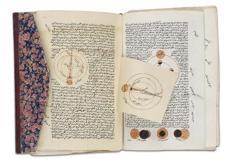Turkey increases presence in UNESCO’s World Memory
ANKARA - Anatolia News Agency

A painting from Osman Hamdi Bey collection.UNESCO’s ‘Memory of the World’ program aims to protect important cultural documents in a digital environment.
The Turkish National Commission for UNESCO is pushing for more of the country’s heritage to feature in the Memory of the World program of the United Nations Educational, Scientific and Cultural Organization (UNESCO). UNESCO’s Memory of the World program was launched in 1992 as a way to preserve and promote documentary heritage, which can take the form of single documents, collections or archives that are deemed to be of such significance as to warrant special protection and international recognition. It reflects and celebrates the diversity of languages, peoples and cultures throughout world history.The program currently features three works from Turkey: the manuscript collection in the archives of Bosphorus University’s Kandilli Earthquake Institute, the cuneiform clay tablets from Boğazköy (the ancient Hittite capital of Hattusha), included in the program in 2001, and the works of Ibn Sina housed in Istanbul’s Süleymaniye Manuscripts Library.
 Turkish National Commission for UNESCO Chairman Professor Öcal Oğuz said that Turkey has many works that could be regarded as significant for the collective memory of humanity and deserve to be shared with the world. “During a meeting, we will gather these works under four main titles.”
Turkish National Commission for UNESCO Chairman Professor Öcal Oğuz said that Turkey has many works that could be regarded as significant for the collective memory of humanity and deserve to be shared with the world. “During a meeting, we will gather these works under four main titles.” Oğuz said that the Memory of the World program aims to protect important cultural documents in a digital environment, against the threats of collective amnesia, neglect, the ravages of time and climate conditions, as well as willful and deliberate destruction.
He said that the need for such a program arose from the loss of many manuscripts and ethnographic or archaeological objects, especially during World War II, and that it aimed to raise awareness about the existence of these works and their significance on a global scale.
Oğuz added that the fourth work being proposed by Turkey for the Memory of the World program was Evliya Çelebi’s “Book of Travels,” a 10-volume account of the journey of a Turkish-Ottoman traveler. “The evaluation process for the inclusion of this work in the program is still ongoing. We expect it will be finalized this year,” he said.
A stronger and richer Turkey
Oğuz said that the Qadesh Peace Treaty and the Hittite Manuscripts from the early ages were also a key part of Turkey’s national memory. “Their existence shows Turkey’s richness in terms of its archives and libraries. It makes the country richer and more valuable for those who want to conduct scientific research. Also, it is important to introduce a country’s cultural heritage to the world. Preserving the documents of the oldest treaties and manuscripts of Turkish and other countries also brings cultural and commercial benefits.”

Qadesh Peace Treaty tablets.
Examples from the Memory of the World
Some of the 58 proposals that have been made at various times to UNESCO by Turkey include: Kasgarlı Mahmud’s “Divan-i Lugat-it Turk,” Yusuf Has Hacib’s “Kutadgu Bilig,” Yunus Emre’s “Risaletü’n Nüshiyye,” “The book of Dede Korkut,” “Dede Efendi,” “Battal Gazi Saga,” TRT’s Turkish Folk Song Archive, miniatures, the Turkish films archive, Atatürk’s Mausoleum Museum and Archive, Nasreddin Hodja manuscripts, Osman Hamdi Bey’s Painting and Photography Collection and documents from the first Turkish Parliament.
Among the foreign works in the Memory of the World program are Austria’s Brahms Collection, Tanzania’s Collection of Arabic Manuscripts and Books, Venezuela’s Collection of Latin American Photographs of the 19th Century, and Saudi Arabia’s earliest Islamic (Kufic) inscription.
















